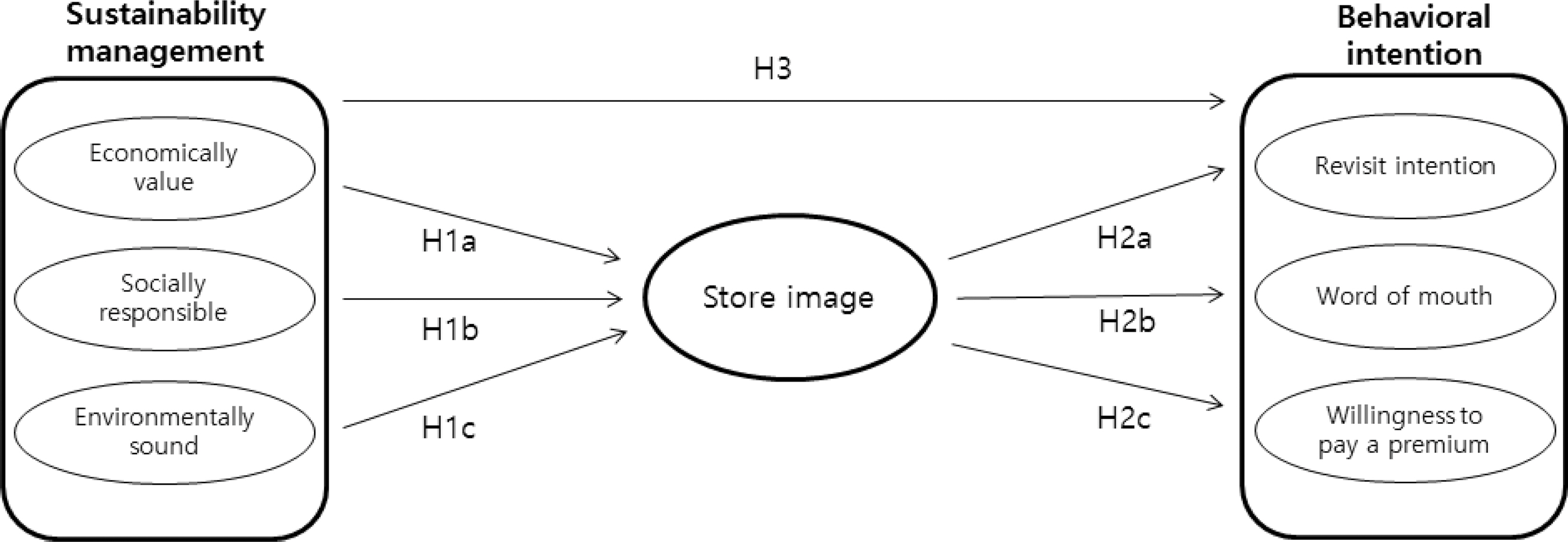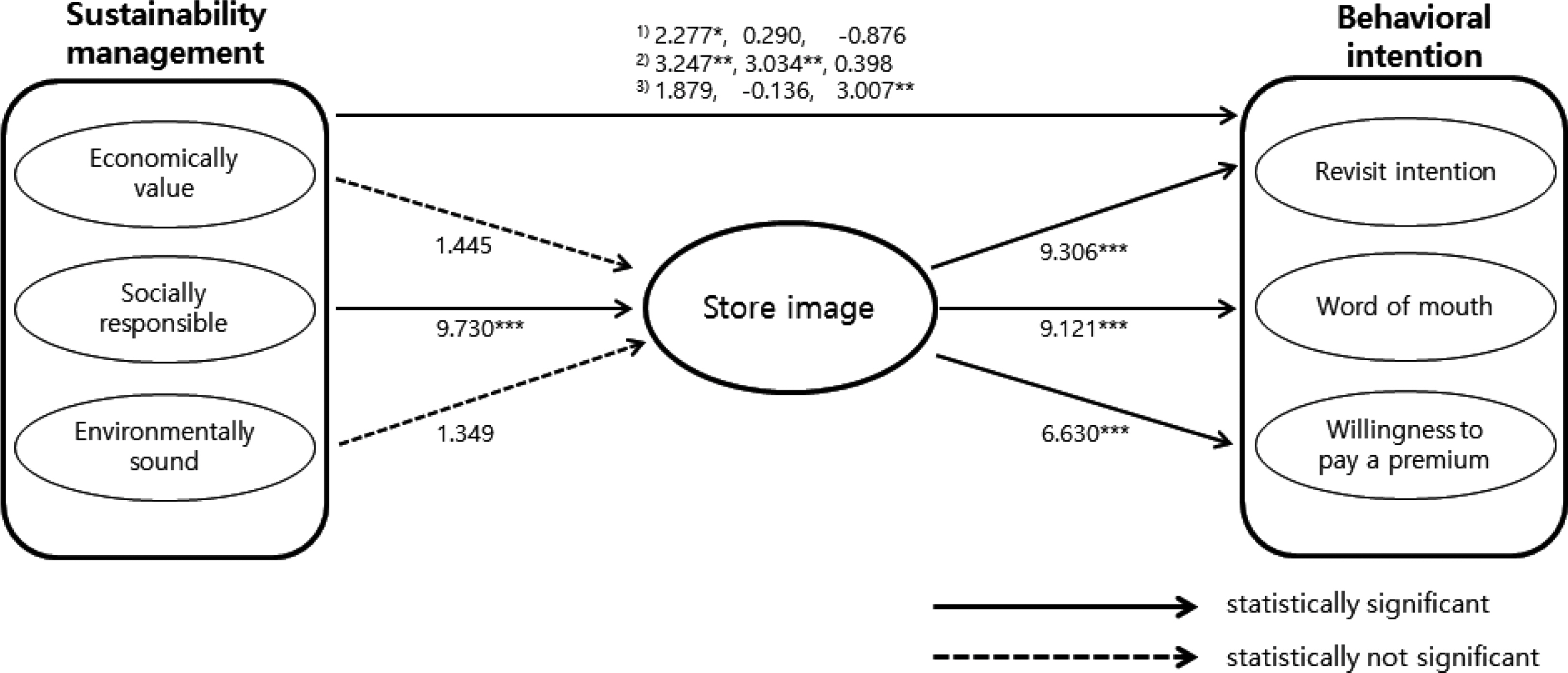J Nutr Health.
2015 Apr;48(2):199-210. 10.4163/jnh.2015.48.2.199.
The influences of sustainability management at institutional foodservice on store image and behavioral intention
- Affiliations
-
- 1Department of Nutritional Science and Food Management, Ewha Womans University, Seoul 120-750, Korea. seo@ewha.ac.kr
- KMID: 2327190
- DOI: http://doi.org/10.4163/jnh.2015.48.2.199
Abstract
- PURPOSE
The purpose of this study was to determine the influence of sustainability management in institutional foodservice on store image and behavioral intention (revisit intention, word of mouth, willingness to pay a premium).
METHODS
Based on a total of 371 samples obtained from the empirical research, this study reviewed the reliability and fitness of the model.
RESULTS
According to results of exploratory factor analysis, sustainability management derived three factors, economic value, socially responsible, and environmentally sound. The structural equation modeling showed that social responsibility in sustainability management had a significant positive effect on store image and behavioral intention. In addition, customer's perceived store image in foodservice had a significant positive effect on behavioral intention. The relationship between sustainability management and behavioral intention was found to be a partially significant effect.
CONCLUSION
The results of this study revealed the importance of sustainability management of foodservice to improve store image and behavioral intention.
Figure
Reference
-
1.Park JC., Oh MJ., Hong SJ. The effects of corporate efforts for the sustainable management on the product evaluation: the mediating role of trust and reciprocity perception. J Mark Manage Res. 2010. 15(3):45–69.2.Harlem Brundtland G. World Commission on environment and development. Environ Policy Law. 1985. 14(1):26–30.3.Elkington J. Cannibals with forks: the triple bottom line of 21st century business. Oxford: Capstone Publishing;1999.4.Dyllick T., Hockerts K. Beyond the business case for corporate sustainability. Bus Strategy Environ. 2002. 11(2):130–141.
Article5.Liou YW., Namkung Y. The effects of restaurant green practices on perceived quality, image and behavioral intention. Korean J Hosp Adm. 2012. 21(2):113–130.6.Chen YS., Chang CH. Enhance green purchase intentions: the roles of green perceived value, green perceived risk, and green trust. Manag Decis. 2012. 50(3):502–520.7.Sustainable Restaurant Association (GB). SRA [Internet]. London: Sustainable Restaurant Association;2009. [cited 2011 Feb 5]. Available from:. http://www.thesra.org.8.Kunkel JH., Berry LL. A behavioral conception of retail image. J Mark. 1968. 32(4):21–27.
Article9.Pan Y., Zinkhan GM. Determinants of retail patronage: a meta-analytical perspective. J Retail. 2006. 82(3):229–243.
Article10.Ryu K., Han H., Kim TH. The relationships among overall quick-casual restaurant image, perceived value, customer satisfaction, and behavioral intentions. Int J Hosp Manag. 2008. 27(3):459–469.
Article11.Fishbein M., Ajzen I. Belief, attitude, intention and behavior: an introduction to theory and research. Reading (MA): Addison-Wesley;1975.12.Cronin JJ Jr., Taylor SA. Measuring service quality: a reexamination and extension. J Mark. 1992. 56(3):55–68.
Article13.Lee HM., Han JS. A study on the impacts of educational service quality on student satisfaction, intention to recommend and word-of-mouth: focusing on international student in universities of Seoul region. Korea J Tourism Hosp Res. 2013. 27(3):55–76.14.Cameron TA., James MD. Estimating willingness to pay from survey data: an alternative pre-test-market evaluation procedure. J Mark Res. 1987. 24(4):389–395.
Article15.Hanemann WM. Willingness to pay and willingness to accept: how much can they differ? Am Econ Rev. 1991. 81(3):635–647.16.Shin J., Kim S., Yoon J. Effect of sustainability management at coffee houses on customers' store image and behavioral intention. Korean J Community Nutr. 2012. 17(4):494–503.
Article17.Lee JS., Hsu LT., Han H., Kim Y. Understanding how consumers view green hotels: how a hotel's green image can influence behavioral intentions. J Sustain Tour. 2010. 18(7):901–914.18.Namkung Y., Jang S. Effects of restaurant green practices on brand equity formation: do green practices really matter? Int J Hosp Manag. 2013. 33:85–95.
Article19.Na D., Lee J., Na Y. Relationship of TBL component in corporate sustainable management of fashion company with company evaluation and brand image. J Korean Soc Clothing Ind. 2014. 16(2):293–300.
Article20.Hong I., Kim Y. LOHAS marketing strategy of fashion company for sustainable image positioning-focus on domestic and foreign case analysis. J Korean Soc Clothing Text. 2011. 35(9):);. 1069–1084.21.Penny WY. The use of environmental management as a facilities management tool in the Macao hotel sector. Facilities. 2007. 25(7-8):286–295.
Article22.Fornell C., Wernerfelt B. Defensive marketing strategy by customer complaint management: a theoretical analysis. J Mark Res. 1987. 24(4):337–346.
Article23.Reichheld FF., Sasser WE Jr. Zero defections: quality comes to services. Harv Bus Rev. 1990. 68(5):105–111.24.Baker J., Grewal D., Parasuraman A. The influence of store environment on quality inferences and store image. J Acad Mark Sci. 1994. 22(4):328–339.
Article25.Ryu K., Lee HR., Kim WG. The influence of the quality of the physical environment, food, and service on restaurant image, customer perceived value, customer satisfaction, and behavioral intentions. Int J Contemp Hosp Manag. 2012. 24(2):200–223.
Article26.Zeithaml VA., Berry LL., Parasuraman A. The behavioral consequences of service quality. J Mark. 1996. 60(2):31–46.
Article27.Maloni MJ., Brown ME. Corporate social responsibility in the supply chain: an application in the food industry. J Bus Ethics. 2006. 68(1):35–52.
Article28.National Restaurant Association (US). NRA [Internet]. Washington, D.C.: National Restaurant Association;1919. [cited 2011 Aug 13]. Available from:. http://restaurant.org.29.Thomas L Jr., Mills JE. Consumer knowledge and expectations of restaurant menus and their governing legislation: a qualitative assessment. J Foodserv. 2006. 17(1):6–22.
Article30.Gupta S., Pirsch J. The influence of a retailer's corporate social responsibility program on re-conceptualizing store image. J Retail Consum Serv. 2008. 15(6):516–526.
Article31.Lantos GP. The boundaries of strategic corporate social responsibility. J Consum Mark. 2001. 18(7):595–632.
Article32.Salzmann O., Ionescu-Somers A., Steger U. The business case for corporate sustainability: literature review and research options. Eur Manag J. 2005. 23(1):27–36.33.Lee HY., Ahn SJ., Yang IS. Case study of menu satisfaction index in business & industry food service. J Korean Soc Food Sci Nutr. 2008. 37(11):1443–1451.34.Cho SY., Park EA. Positioning analysis of franchise coffee brand based on coffee shop selection attributes: focused on Busan area. Korean J Tourism Res. 2014. 28(6):113–135.35.Khil J. Influence of coffee education on importance and satisfaction of coffee house selection attributes in Gwangju and Jeonnam area. Korean J Food Cult. 2012. 27(2):184–192.
Article36.Kim DJ., Chung YH. Effects of coffee shop selection attributes on customer satisfaction and royalty: focused on Daejeon province. Korean J Hosp Adm. 2013. 22(1):131–149.37.Kwon KJ., Han YH. The effect of perception of service scape on hotel restaurant image and royalty, revisit intention in hotel restaurant. J Foodserv Manage. 2013. 16(1):199–218.38.Jung HS., Yoon HH. The influence of corporate social responsibility of family restaurants on image, preference and revisit intention: based on the university students in Seoul. Korean J Culinary Res. 2008. 14(2):138–152.39.Cho YH., Lee GT., Chung KY. The influence of hotel organization's eco-friendly marketing on customer revisit intention. Korean J Hosp Adm. 2014. 23(4):163–179.40.Hu HH., Parsa HG., Self J. The dynamics of green restaurant patronage. Cornell Hosp Q. 2010. 51(3):344–362.
Article41.Namkung Y., Jang S. Are consumers willing to pay more for green practices at restaurants? J Hosp Tourism Res. Forthcoming. 2014.42.Lee K., Conklin M., Cranage DA., Lee S. The role of perceived corporate social responsibility on providing healthful foods and nutrition information with health-consciousness as a moderator. Int J Hosp Manag. 2014. 37:29–37.
Article43.Kozup JC., Creyer EH., Burton S. Making healthful food choices: the influence of health claims and nutrition information on consumers' evaluations of packaged food products and restaurant menu items. J Mark. 2003. 67(2):19–34.
Article44.Schubert F., Kandampully J., Solnet D., Kralj A. Exploring consumer perceptions of green restaurants in the US. Tour Hosp Res. 2010. 10(4):286–300.
Article
- Full Text Links
- Actions
-
Cited
- CITED
-
- Close
- Share
- Similar articles
-
- Effect of Sustainability Management at Coffee Houses on Customers' Store Image and Behavioral Intention
- A Mixed-Methodological Study of Dietitians' Perception and Behavioral Intention towards Sustainable Institutional Foodservice: Focus on Contract Business-and-Industry Foodservice
- Effects of campus dining sustainable practices on consumers’ perception and behavioral intention in the United States
- Factors related to the intention of healthy eating behaviors based on the theory of planned behavior: focused on adults residing in Beijing, China
- Consumer perceptions on sustainable practices implemented in foodservice organizations in Korea



